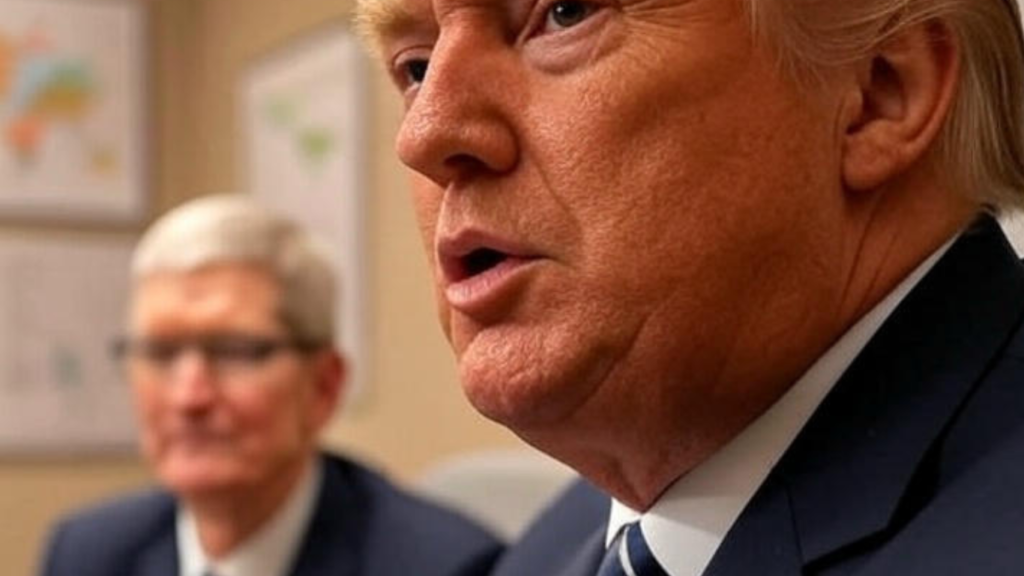In May 2025, U.S. President Donald Trump made headlines by urging Apple CEO Tim Cook to stop expanding iPhone production in India, pushing for more manufacturing in the U.S. This bold statement, made during a business summit in Doha, Qatar, stirred debate about trade, tariffs, and global supply chains. Apple, aiming to produce 25% of its iPhones in India by 2026, has been diversifying from China due to trade tensions. Trump’s comments, tied to his “America First” agenda, challenge India’s growing role as a tech manufacturing hub. This article explores the context of Trump’s request, Apple’s plans, India’s response, and what it means for global trade. With reactions ranging from Indian officials’ calm assurances to social media buzz, the situation highlights complex economic and political dynamics. Let’s dive into why this matters and what might happen next.
The Context of Trump’s Request
On May 15, 2025, Trump spoke at a Doha business summit, expressing frustration with Apple’s growing manufacturing in India. He told Tim Cook, “I don’t want you building in India,” citing India’s high tariffs and Apple’s $500 billion U.S. investment pledge. Trump suggested Apple could produce in India for local markets but should prioritize U.S. production for American consumers. His comments reflect his long-standing push for domestic manufacturing, sparked by trade tensions with China and India’s rising role in Apple’s supply chain. Apple’s shift to India, producing $22 billion worth of iPhones in 2024, aims to reduce reliance on China, where 90% of iPhones are made. Trump’s request, while bold, lacks specific policy details, raising questions about its impact.
Trump’s “America First” Agenda
Trump’s call aligns with his “America First” policy, emphasizing U.S. jobs and manufacturing. He’s long criticized companies like Apple for overseas production, especially in China. Now, he’s targeting India, claiming Apple should bring jobs home, leveraging its $500 billion U.S. investment announced in February 2025. Trump argued that India’s high tariffs—among the world’s highest—make it hard to sell U.S. goods there, justifying his push for domestic production. However, moving iPhone manufacturing to the U.S. is complex due to higher labor costs and limited infrastructure.
Trade Tensions with India
Trump highlighted India’s high tariffs, calling it “one of the highest tariff nations.” In April 2025, he imposed a 26% reciprocal tariff on Indian goods, temporarily lowered until July. He claimed India offered a “no-tariff” deal for U.S. goods, though Indian officials deny linking trade to other issues, like India-Pakistan relations. This context frames Trump’s pressure on Apple, as he sees India’s trade policies as a barrier. Meanwhile, India’s manufacturing incentives, like the PLI scheme, have drawn Apple’s investment, complicating Trump’s demands.
Apple’s Manufacturing Strategy in India
Apple has been ramping up iPhone production in India since 2020, driven by trade tensions with China and India’s production-linked incentive (PLI) scheme. By March 2025, Apple assembled $22 billion worth of iPhones in India, a 60% increase from the prior year, producing about 40 million units annually—15–20% of its global output. Partners like Foxconn and Tata Electronics, which acquired Wistron and Pegatron operations, lead this effort. Apple aims to source most U.S.-bound iPhones from India by June 2025, reducing reliance on China, where 90% of iPhones are made. India’s growing market and subsidies make it a strategic hub, despite Trump’s objections.
Why India?
India offers Apple a vast consumer market and government incentives. The PLI scheme subsidizes manufacturers based on sales growth, helping Apple produce models like the iPhone Pro for global markets. India’s lower labor costs compared to the U.S., combined with a skilled workforce, make it attractive. In 2024, 81.9% of India’s iPhone exports went to the U.S., with exports hitting 3.1 million units in March 2025. Apple’s $435 million Foxconn semiconductor plant, approved in May 2025, further cements India’s role in its supply chain.
Challenges of Moving Production
Shifting iPhone production entirely to the U.S. is tough. Experts note that China’s advanced supply chain, skilled labor, and infrastructure are unmatched. India, while growing, lags in technological prowess. U.S. labor costs are significantly higher—$30/hour versus $3/hour in India—making domestic production costly. Apple’s supply chain, built over decades, involves over 1,000 components sourced globally. Relocating would disrupt this complex network, and the U.S. lacks the manufacturing ecosystem to support it quickly. Apple’s Texas server factory is a start, but full iPhone production remains impractical.
India’s Response to Trump’s Comments
Indian officials downplayed Trump’s remarks, emphasizing the country’s growing role as a mobile manufacturing hub. After Trump’s Doha speech, they contacted Apple executives, who reassured them that investment plans remain unchanged. India sees itself as a competitive manufacturing base, with 40 million iPhones produced annually. The government’s “Make in India” program has attracted global firms, and Apple’s exports, worth Rs. 1.5 lakh crore in FY25, boost the economy. Officials argue that companies like Apple prioritize competitiveness over political rhetoric, confident that India’s ecosystem will keep it a key player.
Government’s Stance
A senior Indian official told India Today that Apple focuses on manufacturing competitiveness, not political pressure. India’s mobile production has soared, with Apple assembling 15% of its iPhones here. The government highlighted the “Make in India” success, noting that global firms value India’s ecosystem. Apple’s commitment to India, including a $435 million chip plant, shows its long-term plans. Officials see Trump’s comments as posturing, unlikely to shift Apple’s strategy, given India’s economic advantages and growing market.
Economic Impact Concerns
Trump’s request raised concerns about India’s tech ambitions. Apple’s exports, up 116% in April 2025 to Rs. 17,219 crore, support jobs and growth. A halt could disrupt this, especially as India aims to rival China in electronics. However, Apple’s assurance to officials calms fears, with no immediate plans to scale back. India’s trade surplus with the U.S. ($45 billion in 2024) adds leverage, but Trump’s tariff threats could complicate matters if trade talks falter.
Apple’s Position and Plans
Apple has stayed quiet publicly but reassured Indian officials that its plans are intact. The company aims to produce 25% of global iPhones in India by 2026, with most U.S.-bound units coming from there by June 2025. This shift, driven by U.S.-China trade wars and India’s incentives, includes Foxconn’s AirPods production in Telangana. Apple’s $500 billion U.S. investment, announced in February 2025, focuses on hiring and facilities, not iPhone production, which remains unfeasible stateside. The company’s silence suggests it’s navigating Trump’s pressure carefully while sticking to its global strategy.
Commitment to India
Apple executives told Indian officials their investment plans won’t change, per PTI reports. India’s role as a manufacturing base grows, with Foxconn and Tata expanding facilities. The $435 million chip plant approval in May 2025 shows Apple’s long-term commitment. Producing 40 million iPhones annually, India is key to diversifying from China. Apple sees India’s market potential and subsidies as vital, despite Trump’s call to prioritize U.S. production.
Balancing U.S. Investments
Apple’s $500 billion U.S. pledge includes hiring 20,000 workers and opening facilities, like a Texas server plant. However, iPhone production in the U.S. is unlikely due to high costs and no existing smartphone plants. During a May 2025 earnings call, Tim Cook emphasized diversifying supply chains to reduce risk, citing India and Vietnam as key hubs. Apple’s strategy balances U.S. investments with global efficiency, likely resisting Trump’s push while maintaining diplomatic relations.
Global Trade and Tariff Dynamics
Trump’s request ties into broader U.S.-India trade talks. He claimed India offered a “no-tariff” deal, though Indian officials deny this, focusing on a Bilateral Trade Agreement. India’s high tariffs—among the world’s highest—prompted Trump’s 26% reciprocal tariff in April 2025, paused until July. Apple’s India shift helps avoid U.S. tariffs on Chinese goods (up to 145% in 2024). Meanwhile, a U.S.-China trade deal in May 2025 lowered tariffs to 30% and 10%, respectively, for 90 days, easing pressure but not halting Apple’s diversification. These dynamics shape Trump’s push and Apple’s strategy.
U.S.-India Trade Talks
India and the U.S. are negotiating a trade deal, with Commerce Minister Piyush Goyal visiting the U.S. on May 17, 2025. Trump’s claim of a “no-tariff” offer lacks confirmation, and India denies linking trade to other issues. Bilateral trade hit $129 billion in 2024, with India holding a $45 billion surplus. Trump’s tariffs aim to balance this, but India’s manufacturing incentives keep it attractive for Apple. A deal could ease tensions, but Trump’s rhetoric may complicate talks.
Impact of U.S.-China Trade War
The U.S.-China trade war, with tariffs reaching 145% on Chinese goods, pushed Apple to India. Harsh COVID lockdowns in China and geopolitical tensions accelerated this shift. India’s 8.4% share of global phone production, compared to China’s 76.6%, is growing, with 97.6% of India’s iPhone exports going to the U.S. in March 2025. A temporary U.S.-China tariff reduction in May 2025 offers relief, but Apple’s long-term plan leans on India to avoid future risks.
Public and Industry Reactions
Trump’s comments sparked varied reactions. Indian officials, confident in their manufacturing hub status, downplayed the issue, citing Apple’s assurances. On X, posts reflected mixed sentiments—some criticized Trump’s interference, others saw it as political posturing. Industry experts, like Counterpoint’s Tarun Pathak, noted that moving production to the U.S. is “not going to happen overnight” due to supply chain complexities. Apple’s silence suggests caution, while its commitment to India reassures stakeholders. The debate highlights tensions between global economics and political agendas, with no clear resolution yet.
Social Media Buzz
X posts captured diverse views. One post praised India’s “Make in India” strength, noting Apple’s unchanged plans. @WaqarHasan1231 criticized Trump’s meddling, linking it to broader India-U.S. issues. Anothe highlighted the $435 million Foxconn chip plant, showing India’s growing role. Some users mocked Trump’s understanding of manufacturing, citing his lack of expertise. Others saw his comments as a tactic to boost U.S. job narratives. The online chatter reflects both support for India’s tech ambitions and skepticism of Trump’s approach.
Expert Insights
Analysts like Tarun Pathak argue that Apple’s supply chain, built over decades, can’t shift to the U.S. quickly. Rachel Wu, quoted in What’s Trending, called global manufacturing an “intricate web,” noting high U.S. costs. S&P Global data shows India’s iPhone exports surged 219% in March 2025, driven by U.S. demand. Experts see Trump’s request as symbolic, unlikely to derail Apple’s plans given India’s cost advantages and infrastructure investments. They emphasize that Apple’s decisions prioritize economics over politics.
What’s Next for Apple and India?
Trump’s request puts Apple in a tricky spot, balancing U.S. political pressure with global efficiency. Apple’s assurance to India suggests it will continue expanding there, with plans to produce 25% of iPhones by 2026. However, Trump’s tariff threats or new policies could add pressure, especially if U.S.-India trade talks falter. India’s government remains optimistic, banking on its manufacturing ecosystem. For now, Apple’s $435 million chip plant and growing exports signal confidence in India. The situation may evolve as trade negotiations progress, but Apple’s diversified strategy likely won’t shift drastically soon.
Apple’s Long-Term Strategy
Apple’s goal is to reduce reliance on China, with India as a key hub. By 2026, it plans to import most U.S.-bound iPhones from India, leveraging the PLI scheme and lower costs. Foxconn and Tata are expanding facilities, and AirPods production in Telangana shows diversification. Apple’s $500 billion U.S. investment focuses on non-manufacturing areas, like hiring and R&D, avoiding costly iPhone production stateside. This hybrid approach balances global markets while addressing U.S. demands.
Potential Policy Impacts
If Trump pushes tariffs or restrictions, Apple could face higher costs for India-made iPhones exported to the U.S. A U.S.-India trade deal, possibly easing tariffs, could counter this, but talks are ongoing. India’s $45 billion trade surplus with the U.S. gives it leverage, but Trump’s unpredictable policies keep uncertainty high. Apple may navigate this by boosting U.S. investments in non-production areas while maintaining India’s role, ensuring flexibility in a volatile trade landscape.
Tips for Understanding the Situation
To grasp Trump’s request and its implications, follow trade news closely. Check reliable sources like Bloomberg or PTI for updates on U.S.-India talks. Understand Apple’s supply chain challenges—moving production to the U.S. isn’t simple due to costs and infrastructure. India’s “Make in India” program and Apple’s $22 billion in iPhone exports show its growing role. On X, look for posts from tech analysts or Indian officials for real-time reactions, but verify claims. Expect Apple to stay quiet publicly while working behind the scenes. The outcome depends on trade deals and Apple’s strategic choices, so stay informed as events unfold.
Following Trade Developments
Monitor U.S.-India trade talks, especially Commerce Minister Piyush Goyal’s May 17, 2025, U.S. visit. A deal could ease tariff tensions, impacting Apple’s plans. Watch for Trump’s policy moves, like new tariffs, which could raise iPhone costs. Sources like The Economic Times or S&P Global offer data on India’s exports (e.g., 3.1 million iPhones in March 2025). X posts from @bsindia or @mlqai provide quick updates but check facts, as opinions vary. Staying updated helps you understand the bigger picture.
Evaluating Apple’s Moves
Apple’s silence suggests a cautious approach, but its reassurance to India shows commitment. Look at its actions—expanding Foxconn and Tata facilities, launching a $435 million chip plant. These signal India’s long-term role. Compare this to its U.S. plans, like the Texas server factory, which focus on non-smartphone production. Analysts on X, like @pstAsiatech, note Apple’s need for global diversification. Understanding these moves shows why Apple resists a full U.S. shift despite Trump’s pressure.



